Blossom Pink | Source: How colour takes us on a journey
Source | Connections | Physis | Sense
“Without regret
They fall and scatter
Cherry blossoms”
— Kobayashi Issa, 1763-18.
The Essential Haiku, edited and translated by Robert Hass.
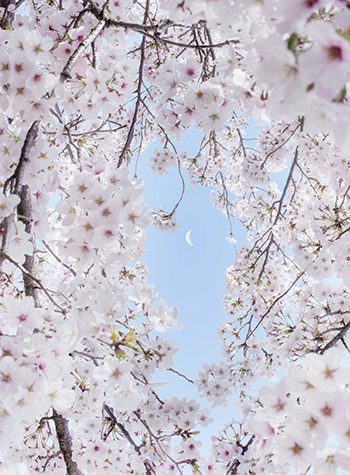
Sakura I, 2019 © Andrea Hamilton
If you have ever contemplated blossom pattering from a tree like rain, the exquisite purity of fresh snowfall – so quick to sully and melt – or watched migrating birds leaving for sunnier shores and felt a deep pang, you have felt mono no aware. One of the abiding characteristics of Japanese culture, the phrase literally means ‘thing of pathos’, but it is so much more than that. This almost untranslatable concept sums up the feeling that all things, no matter how beautiful, must come to an end. It is the bittersweet poignancy and acceptance of the shortness of life. In the immortal words of Dylan Thomas, Western culture likes to: “Rage, rage against the dying of the light”; by contrast Japanese culture, rooted in Shintoism and nature, accepts it.
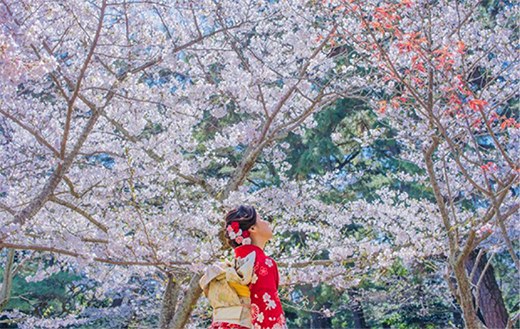
Sakura and Maiko, 2019 © Andrea Hamilton
Mono no aware reaches its apogee in hanami (lit. flower view), the practice of cherry blossom viewing in spring, when the entire nation turns out to enjoy millions of prunus trees as they bloom in every part of the country, offering billowing clouds and drifts of softest pink. The practice is at least 1,300 years old, originating in the Nara period, and is best experienced while enjoying a picnic with friends and family: hanami is about gathering with those you love while taking in the beauty of the blooms.
The fragile pink of the cherry blossom reminds us of the wonder of loving family and friends. It speaks of growth, renewal and the coming of spring. But it also warns us to celebrate when we can: it is too easy to gallop through life with our eyes trained on an imaginary finish line. Mono no aware provokes us to pay attention to the here and now before it disappears. This moment will never happen again. There is sadness here, true; this beauty will end, our existence burns so brightly for such a short, vivid time.
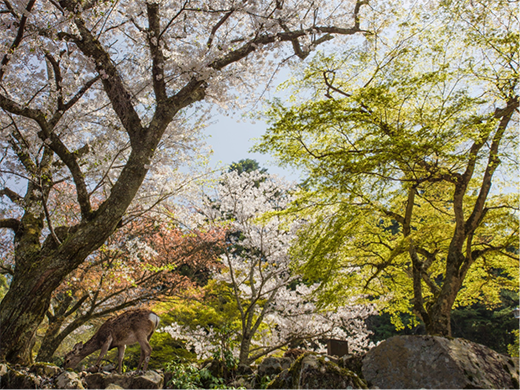
Fawn and Sakura, 2019 © Andrea Hamilton
Mono no aware also holds a deep hope and a truth within it: all things are cyclical. There is the implicit promise of rebirth. The cherry blossom will come again, the tides ebb and flow and the clouds will part once more. Only in accepting that the blossom must fade can we start the cycle of growth and renewal and a new future. But what of the roots? They remain: what would our world be with no memory of itself, no accumulation of knowledge? For fresh blooms to rise, branches can be cut back but the roots must be strong, to send fresh vigour.

Blossom Pink with Blue Sea, 2018 © Andrea Hamilton
The pale pink of cherry blossom and its symbolism in Japanese literature flavours all aspects of creative life, from Soseki Natsume’s seminal novel Kokoro to Takashi Murakami’s delirious, pop-art sakura and Mariko Mori’s futuristic images.
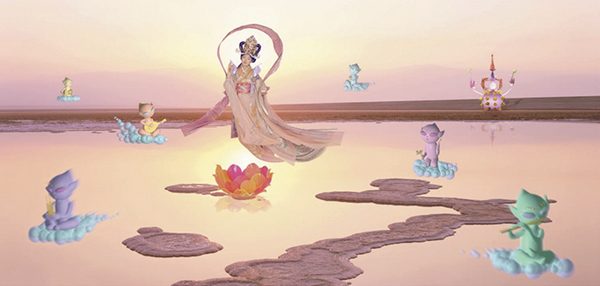
Pure Land, 1996-1998 © Mariko Mori
Takashi Murakami’s pop flowers – happy-faced blossoms are like Andy Warhol’s Pop flowers. They sprang out of his desire to create something contemporary but uniquely Japanese in response to a culture increasingly dominated by “a deep appropriation of Western trends.”
Murakami borrows from the power of the blossom in the psyche, the kawaii (cute) aesthetic, from anime (cartoons) and manga (graphic novels) to the larger subculture of otaku, as well as the old masters of woodblock and Buddhist iconography, to create a distinct world, popping with colour, both deeply current and rooted in the old. His ‘smiling flowers’ might be kawaii but carry a darker taste, often painted side by side with black skulls, like a Dutch vanitas painting, reminding us that nothing lasts. Murakami has succeeded in grafting his own superflat branch of culture onto the trunk of Japanese art history.
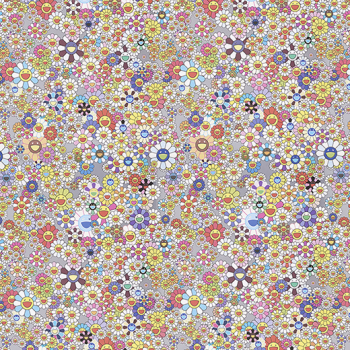
Flower Smile, 2011 © Takashi Murakami
It is a potent combination, and his prolific aesthetic (painting, sculpture, installation, animated film, plus pieces created by his company Kaikai Kiki) has become internationally recognised, appealing to both the high and low brow. In fact, it twins with another commodifier of art: the YBA ‘bad boy’ Damien Hirst.
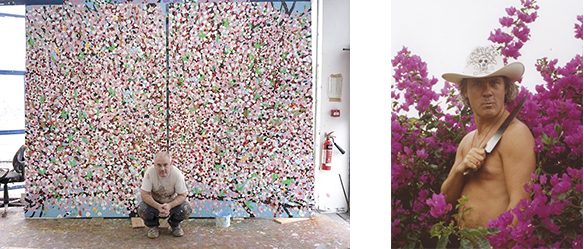
Damien Hirst with one of his new cherry blossom paintings. Photo by Prudence Cummings © Damien Hirst and Science Ltd. | Damien Hirst, Mexico City, 2006 © Johnnie Shand Kydd
Hirst is an artist with deep roots in the conceptual. Fêted for his studio built works like The Physical Impossibility of Death in the Mind of Someone Living (1991), recently, Hirst has been spending time in his studio alone, painting. Emboldened by the immediacy of painting, Hirst has become rooted into the one aspect of his practice that has never let him down: colour. Inspired by the great colourist Bonnard he first painted a series of brightly-coloured, thick impasto works titled Veil Paintings.
Through blossoms, Hirst acknowledges a sense of the fleeting, fragile nature of his place on the bough of British contemporary art. These paintings also ask questions about his own mortality, and we sense mono no aware: the little time he has left to make something meaningful, touch life with his fingertips and feel connected to the world. For blossom may be ephemeral and pink the colour of youth, but trees – and their deep roots – are very real indeed.
Blossom pink is a colour that touches the soul, calls us to spring and renewal, reminds us to enjoy earthly beauty and our fleeting time here, beautifully captured by Vincent van Gogh who himself died in full bloom. It is this aspect of the cherry tree, its brief moment of beauty in bloom, that gives the subtle sculptures of Hans Op de Beeck such poignancy. Life, like little blossoms, is clinging to the petrified branches.
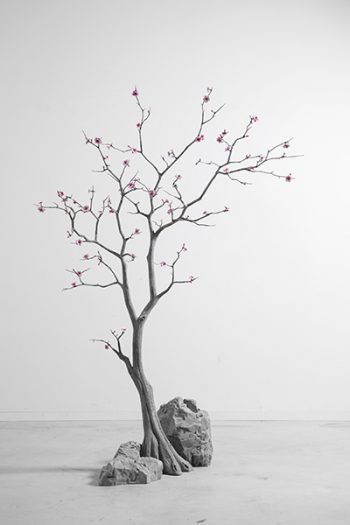
Blossom Trees, 2018 © Hand Op de Beeck
In the West, soft pink is associated with love, kindness and femininity. As it is associated with unconditional love and opening your heart, it assists with releasing emotional challenges. In the East it is also connected to love but seen as neither masculine or feminine, instead referring to youth and transience.
Explore Further
Exhibitions:
18 March – 8 July 2019: Damien Hirst: Cherry Blossoms. The Portland Art Museum, Portland, USA.
23 July 2018 – 7 July 2019: Jenny Holzer, Tate Modern, London.
24 June – 22 September 2019: Nick Knight, Albon Barn, Little Milton. By appointment only.
2 February – 1 September 2019: Christian Dior: Designer of Dreams. V&A Museum, London.
14 June – 9 August 2019: Fragile Land series by Ori Gersht at Noga Gallery, Israel.
Source | Connections | Physis | Sense